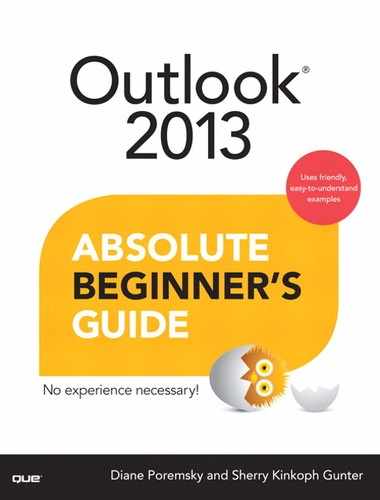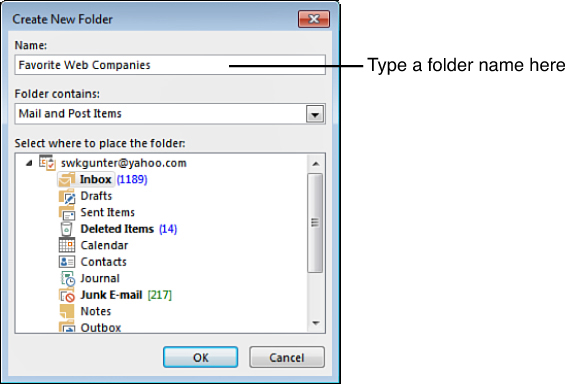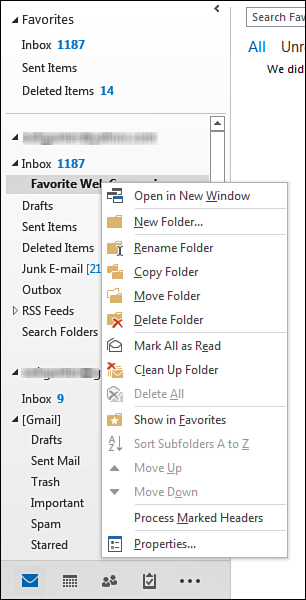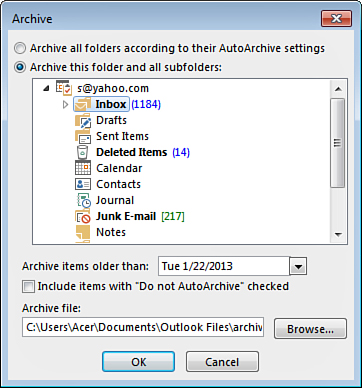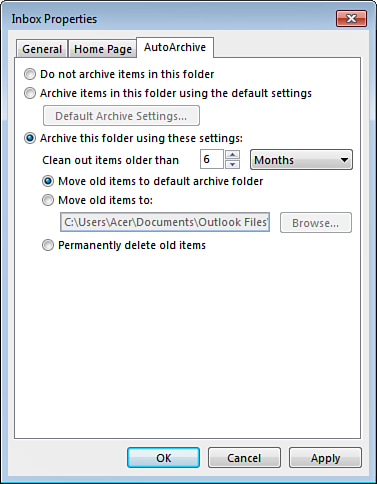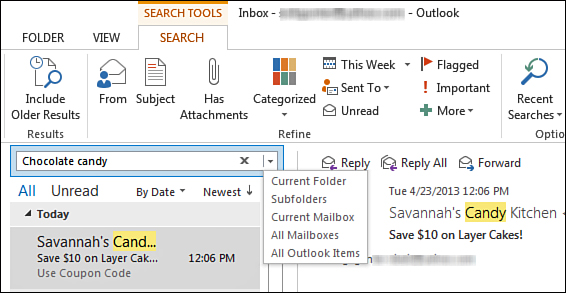5. Managing Email
In This Chapter
• Organizing messages into folders
• Automating your Inbox with Quick Steps
• Sending incoming email to different folders for easy organizing
• Stopping junk email from reaching your Inbox
• Archiving old messages so they don’t languish in your mail folders
• Learning how to look for a message in a haystack
As your email messages start piling up, you eventually need to plan out ways to manage them or your Inbox is going to seem like it’s bursting at the seams. Thankfully, Outlook makes it easy to choose how you want to organize and store messages. In fact, this is where Outlook puts the word “manage” in personal information manager and kicks it into high gear.
Although it may be tempting to let messages turn into a mountain in your Inbox, don’t. You can opt for a variety of handy methods for dealing with them efficiently:
• Store messages in special folders so they stay neat and tidy (OCD people are going to love this one).
• Delete messages you don’t want to keep so your Inbox isn’t clogged.
• Archive messages to move older messages out of the way, yet keep them available if needed again.
• Thin down your incoming deluge of messages by creating rules to sort email.
• Weed out junk mail before it even makes it into the Inbox.
• Route messages to the right places using Quick Steps.
In this chapter, you’ll learn essential techniques for keeping ahead of your email stack.
Organizing Messages with Folders
In case you haven’t noticed yet, every message you receive for a particular email service appears in the account’s Inbox folder listed over in the Folder pane. You’re not stuck using just your Inbox to contain your messages. You can use the folder structure hierarchy to organize and manage email into logical containers. In the same way you use folders to organize files on your computer, you can use folders in Outlook to store and sort email messages.
Each email account includes a set of default folders, one of which is the main Inbox for the account where your messages tend to pile up. Other folders may include Drafts, Sent Items, Deleted Items, Junk E-mail, and Outbox. (These may vary depending on your email service.) Most of the preexisting folders are self-explanatory based on their names alone, but you can also add more folders to help you better organize your messages. For example, you may want to keep all your departmental emails in a folder labeled Sales Department, or all of your business correspondence in a folder labeled Clients. You can create as many folders as you need, even for temporary projects and tasks.
 Tip
Tip
You can learn more about using folders to organize other Outlook items in Chapter 15, “Using Folders.” Meanwhile, in this section, we’ll focus strictly on using folders for email messages.
Making a New Email Folder
Follow these steps to create a new folder:
1. With the Mail module displayed onscreen, click the Inbox folder under the email service you want to add a folder to (see Figure 5.1).
2. Click the Folder tab on the ribbon.
3. Click the New Folder button.
4. Outlook opens the Create New Folder dialog box, as shown in Figure 5.2. Type a name for the new folder in the Name box.
5. Leave the other settings intact (Mail and Post Items is selected in the Folder Contains box, and the Inbox you selected in step 1 is highlighted in the Select Where to Place the Folder list box).
6. Click OK.
Outlook adds the new folder to the Folder pane, similar to Figure 5.3. Now you can start moving messages to the folder as needed.
 Tip
Tip
You can also right-click the Inbox name and choose New Folder from the context menu that pops up; then type in a new folder name directly without using the Create New Folder dialog box.
 Tip
Tip
Adding folders is a key part of using some of Outlook’s other message management features, such as rerouting incoming emails to designated folders. Sometimes it helps to plan out ahead of time what types of folders you might need later, such as a work project or important client you’re corresponding with. You can always remove folders you no longer need and archive any old messages.
Moving a Message to Your New Folder
To move a message to a folder, you can drag and drop it in place. You can also use this method:
1. Click the title of the message you want to move.
2. Click the Home tab.
3. Click the Move button.
4. Select the name of the folder where you want to place the message (see Figure 5.4).
If the folder you want to use isn’t listed in the Move menu, click the Other Folder option and use the Move Items dialog box to choose your folder.
Working with Folder Contents
While we’re on the subject of folders, let’s go over the ways you can work with them, view their contents, and purge contents you no longer want to keep.
• To view any folder in your Folder pane, click the folder name. The Mail module immediately displays a list of contents, and if the Reading pane is displayed, you can view entire messages.
• To rename a folder you’ve added yourself, click its name twice and type in a new name, or right-click it and choose Rename Folder.
• To remove a custom folder, right-click it and choose Delete Folder (see Figure 5.5).
• To move the folder, right-click the folder name, choose Move Folder, and then choose where to move it.
• You can copy a folder. Right-click the folder name and choose Copy Folder, and then tell Outlook where to copy it to.
• To remove a message from a folder, right-click it and choose Delete or press the Delete key, or click the Delete button on the Home tab. So many deletes. As soon as you activate a Delete command, Outlook moves the message to the Deleted Items folder.
• To empty out your Deleted Items folder, right-click the folder name and choose Empty Folder. A prompt box appears, telling you that you’re about to delete stuff forever. Click Yes to make it happen.
• To clean out your Junk E-mail folder, right-click the folder and choose Clean Up Folder. A prompt box appears, warning you that you’re about to move messages to the Deleted Items folder; click Clean Up Folder to proceed.
Your Sent Items folder keeps a copy of all the emails you send. This feature is turned on by default, which makes it a nice safeguard in case you need to find a message later.
You can learn more about working with Outlook folders in Chapter 15, including how to manage other data types in them.
Routing Messages with Quick Steps
You can use Outlook’s Quick Steps feature to perform multiple actions on your email messages with just one click. For example, you might want to flag a message for follow up later and move it to a special folder. Rather than do the two actions separately, why not do them at the same time? That’s where Quick Steps come into play.
Outlook stores Quick Steps in the Quick Steps gallery on the Home tab when you’re using the Mail module. You can scroll through the gallery to view them or expand the gallery to view all of them at once. Outlook even includes a few preset Quick Steps you can take advantage of:
• Move To—If you find yourself moving messages to the same folder over and over, designate it as the Move To folder and use this Quick Step to immediately relocate messages.
• To Manager—This opens a message form that’s automatically preset with a designated recipient, such as your manager (hence the name), along with the forwarded message.
• Team Email—Use this Quick Step to send a new message to everyone on a team. All the member’s email addresses are saved and preloaded in the form window, ready to go.
• Done—This marks the selected message as read, completed (with a Mark Complete flag), and moves it to a designated folder—three things at once.
• Reply and Delete—This one opens a reply form to send back a reply and also moves the original message to the Deleted Items folder.
To practice using one of the default Quick Steps, you can try out the one that moves messages. While viewing your Inbox messages in the Mail module, select the message you want to dispatch (click it or tap it to select it). Next, make sure the Home tab is displayed and click the Move to: ? Quick Step from the Quick Step gallery, as shown in Figure 5.6. If the Move to: ? option isn’t in view, scroll through the gallery to locate it.
When you activate the option, the First Time Setup dialog box appears, similar to Figure 5.7. The same box opens for some of the other Quick Steps the first time you use them. That’s because you need to specify people or folders first so Outlook can carry out the actions. To designate a folder to move the selected message to, click the drop-down arrow and specify a folder name.
The Mark as Read check box is also conveniently selected. You can leave it checked if you want to consider the message read; uncheck it if you want to move it and treat it as not read yet.
Finally, click the Save button. Outlook saves the folder name as your designated folder and adjusts the Quick Step name accordingly. The next time you want to move a message, click the option listed in the Quick Steps gallery, and Outlook takes care of the relocation for you. You can use the Quick Steps gallery on the Home tab to make your selection, or you can right-click the message, choose Quick Steps, and then choose the name of your step.
Need to make a folder? Back up to the previous section to learn how to add folders to your Inbox to organize messages.
As you can imagine, you can create different Quick Steps to handle various ways you want to process email messages. You can move, copy, and delete messages, change their status from read to unread, assign categories and flags, generate automatic message responses, turn them into appointments, and so on. You can assign as many actions to a Quick Step as you want.
To build a custom Quick Step, choose the Create New option from the Quick Steps gallery. This opens the Edit Quick Step dialog box, shown in Figure 5.8, and you can choose actions, folders, even type out ToolTip text to pop-up to remind you what the step does when you hover the mouse pointer over the Quick Step name. Yes, those Microsoft people have thought of everything.
You can open the Manage Quick Steps dialog box (see Figure 5.9) to make changes to actions associated with Quick Steps or remove Quick Steps you no longer want. From the Quick Steps gallery, select the Manage Quick Steps option to display the dialog box. Choose which Quick Step you want to edit, then click the Edit button to make changes to the associated actions, or click the Delete button to remove it entirely from the list. You can also duplicate a Quick Step and tweak it slightly to create a new step. Go wild and make Quick Steps for everything—it’s fun.
 Tip
Tip
What? Don’t like the order of your Quick Steps in the gallery? Reorder them in the Manage Quick Steps dialog box. Use the arrow buttons to reposition how a step is listed in the bunch.
Managing Incoming Messages with Rules
How would you like to set a few rules for your email messages, such as telling all the emails from a certain friend to go jump in a Boring folder, or put all the messages from your boss into a Do This Now folder? You can set rules in Outlook that help you sort through your email and put them in special locations, among other actions. Rules can help you move, copy, delete, reply to, forward, and redirect your email. You can choose from Outlook’s preset rules or create brand new ones. Are you ready to lay down the law? Let’s break out the rule book.
You can build rules with help from Outlook’s Rules Wizard, a step-by-step process for creating a rule (click the Advanced Options button in the Create Rule dialog box to summon the wizard for help). However, one of the easiest ways to build a rule is to grab an example of an existing message you want to create a rule for, such as an email from a certain person that you always want routed to a certain folder, and build on it. With the Mail module displayed, follow these steps:
1. Select the message you want to turn into a rule.
2. Click the Home tab.
3. Click Rules (see Figure 5.10).
4. Click Create Rule to open the Create Rule dialog box, shown in Figure 5.11.
5. Use the conditions check boxes to set the criteria for the email. You can specify messages from that particular sender, identify subject matter to recognize, or who the message was originally sent to, for example.
6. Under the Do the Following group, choose what you want Outlook to do when it encounters these same message types in the future, such as moving them to a specified folder.
7. Click OK and the rule is set for any incoming messages resembling the criteria you specified.
8. Outlook asks if you want to run the rule immediately. Click the check box and click OK to do so, or click OK to exit without running the rule yet.
You can manage any rules you create with a little help from the Rules and Alerts dialog box, shown in Figure 5.12. To find your way to this box, click the Rules drop-down arrow on the Home tab and choose Manage Rules and Alerts. You can also access the box through Outlook’s Backstage view; click the File tab, click Info, and then click Manage Rules and Alerts.
• To turn off a rule, deselect its check box.
• To remove a rule, select it and click the Delete button.
• To edit a rule, select it and choose Change Rule, Edit Rule Settings.
• To add a new rule, click New Rule.
When you finish with rules, click OK to exit the dialog box.
Controlling Junk Email
Junk email is a broad term covering advertising emails, unsolicited bulk emails, spam, or just about anything sent to your email address without your consent. Billions of spam emails are sent daily, and they’re not always just about advertising something. Spam email can also be criminal in nature, generated by hackers and “phishers” trying to steal your identity or personal information for nefarious reasons. Thwarting junk email from reaching your Inbox requires some filtering on Outlook’s part. Although it can’t catch everything all the time, Outlook’s filtering tools do a pretty good job of sorting out the bad stuff and placing it in a special folder marked for such unworthy messages.
You can even fine-tune the sensitivity settings to low or high to suit your needs. Choose from the following options:
• No Automatic Filtering—This setting means there’s no filtering happening at all. Junk mail can flow freely into your Inbox.
• Low—Some junk mail still gets through, but the worst of it is tossed away.
• High—The most ruthless setting; nothing gets through, sometimes not even legitimate emails (be sure to check the Junk E-mail folder periodically to see if anything important gets tossed in by mistake).
• Safe Lists Only—This setting allows only emails from specified companies and individuals (from your safe recipients list) to make it into your Inbox. You have to identify senders first in a special Safe Senders list (sort of like a guest list for your email, and only the invitees make it into the party).
In addition to setting a filtering level, you can also choose to go ahead and permanently delete junk email when it’s found, disable links in suspected phishing messages, or display a warning prompt for suspicious domain names for a heads up.
To adjust your junk mail settings, follow these steps:
1. From the Mail module, click the Home tab. If you have more than one email service, select the account’s Inbox first.
2. Click the Junk drop-down arrow, shown in Figure 5.13.
3. Click Junk E-mail Options. The Junk E-mail Options dialog box opens to the Options tab, as shown in Figure 5.14.
5. Click OK.
You can also help Outlook identify junk email by pointing it out when you find it in your Inbox. Right-click the icky message from the list, click Junk, then choose the Block Sender option.
If you find the filter dumping legitimate messages into the Junk E-mail folder, display the folder’s contents (click the folder name in the Folder pane), right-click the message from the list, and choose Never Block Sender or Not Junk (see Figure 5.15).
 Tip
Tip
If you’re concerned Outlook might identify email messages from someone as junk, like the weekly family updates from Uncle Marvin, you can add the individual to your Safe Recipient’s list. From the Junk E-Mail Options dialog box (see Figure 5.14), click the Safe Recipients tab and click Add, and then type in the user’s address.
Archiving Messages
Sure, deleting old messages is a great way to clean out your Inbox, but sometimes you need to hang on to your messages for posterity, or in case you need to refer to them again to recall an exchange. You can archive messages, sort of like putting them into storage, but without the mothballs or monthly rental fee.
You can archive manually or automate the task. Outlook’s AutoArchive tool is perfect for taking care of archiving tasks in the background without any help from you. You can set different archiving tasks for different folders. For example, you can instruct the tool to automatically archive messages in your Inbox that are older than 3 months and move them to a special archive folder.
By default, Outlook is set up to archive messages to a file named archive.pst. You can specify another location for your archive files as well as specify more descriptive filenames.
Manually Archive Messages
If you’re doing a little folder cleaning, you can manually archive messages. For example, you might be wrapping up a work project and need to put all the email messages associated with it into an archive file.
To manually archive messages, follow these steps:
1. Click the File tab.
2. Click Info.
3. Click Cleanup Tools (see Figure 5.16).
4. Click Archive to open the Archive dialog box shown in Figure 5.17.
5. Click the folder you want to archive.
6. Choose a cutoff date, such as items older than 6 months.
7. Choose an archive file location (click the Browse button, navigate to the location, and specify a more descriptive filename), or use the default filename and locations.
8. Click OK, and Outlook archives the messages.
Setting Up Automatic Archiving
You can instruct Outlook to perform automatic archiving for you. You can set automatic archiving for individual folders or the Inbox in general. To set up automatic archiving, follow these steps:
1. Select the folder or subfolder you want to archive, such as your Inbox or an old project folder.
2. Click the Folder tab.
3. Click the AutoArchive Settings button.
4. Outlook opens the Junk E-mail Properties dialog box to the AutoArchive tab of tools, as shown in Figure 5.18. Click Archive this folder using these settings option.
5. Specify the age of the messages, such as older than 3 months.
6. Specify a location for the archived file, or use the default location.
7. Click OK.
Each folder can have its own archiving settings, which is handy if you don’t want some folders tampered with, but others are good to square away.
 Tip
Tip
Want to check out how much room is being consumed in your Inbox? Switch over to Backstage view (click the File tab) and click the Cleanup Tools button, then click Mailbox Cleanup. This opens the Mailbox Cleanup dialog box. Click the View Mailbox Size button to check out how much room is taken up by your messages in the various folders. Based on what you see, you may decide you need to clean up some folders and archive old messages.
Searching for Messages
As your digital stack of email grows, so does the inevitable need to search through them for a particular message. If you’re worried that searching for a message may be like looking for a needle in a haystack, don’t sweat it. Outlook has tools you can use to look for messages. In fact, Outlook taps into the Windows Search technology, which means you can even search for Outlook items from the Windows Start menu (Windows 7) or using the Windows 8 search screen.
Conducting a Quick Search
When you select an Inbox to view in the Mail module, a search box appears at the top of the list, much like the one found in Figure 5.19. You can click in the box and type any keyword or words you want to search for, whether it’s a name, subject title, or a word within the message body. As soon as you start typing, Outlook starts searching. Any matches are listed, newest emails first, similar to Figure 5.20. Outlook also opens a Search tab on the ribbon with additional search tools you can access and apply.

FIGURE 5.19 Use the search box at the top of the message list to search for messages in that particular Inbox or folder.
You can narrow the search by adjusting the keyword or words you search for, or by tweaking the search criteria, such as searching subject lines or recipient names. To add search criteria, select among the Refine group of tools on the Search tab and then type in your refining keyword or words in the search box, similar to Figure 5.21. You can also click the drop-down arrow on the search box to change which folder or Inbox you search.
When you finish with your search, click the Close Search button on the Search tab.
 Tip
Tip
Performing a sort can help you find messages by subject, name, or date. To perform a quick sort, click the sort category at the top of your message list, such as Subject or From. If you turn off the Reading Pane, you can view more sort categories.
Making Search Folders
You can use Outlook’s Search folders to speed up searching tasks. A Search folder gives you a spot to look for certain kinds of messages regardless of where they’re actually located. It’s rather like a catalog of messages pertaining to a set of criteria. Search folders can save you quite a bit of time and energy otherwise searching through a vast amount of messages. Plus, after they’re established, Outlook keeps your Search folders up to date.
Outlook offers several preset Search folders you can use. For example, the Mail Flagged for Follow Up folder shows only messages you’ve flagged, whereas the Unread Mail folder shows only messages you haven’t read yet.
To create a custom search folder, click the New Search Folder button on the Folder tab. The New Search Folder dialog box opens, similar to Figure 5.22. Choose the type of Search folder you want to add. If you’re making a custom folder, click the Choose button to fill in any additional information required by the type. When you finish filling out details, click OK.
To search your Search folder, click the folder name and a list of messages immediately appears. To exit the folder, click the Inbox again.
See Chapter 16 to learn more about searching in Outlook.
